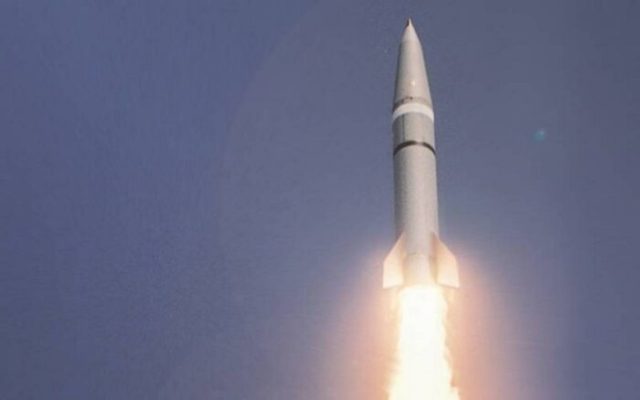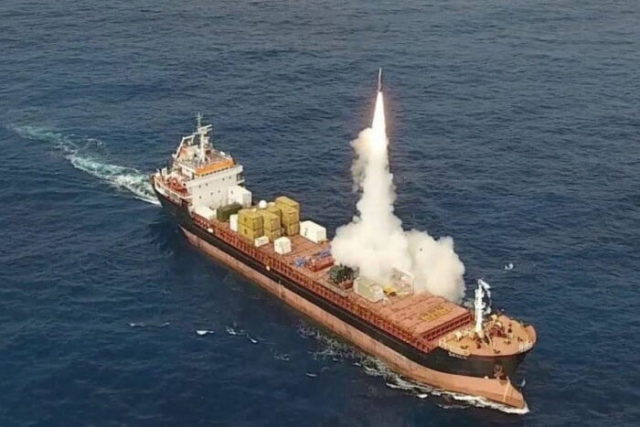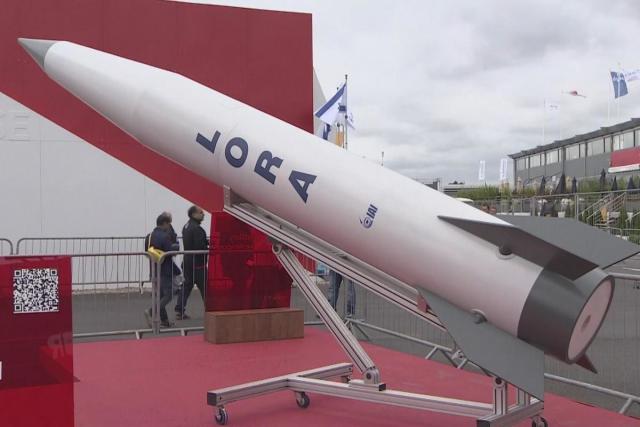According to Chinese specialized sources, the designers of the Israeli military-industrial company Israel Aerospace Industries (IAI) began developing the highly mobile LORA RTR in mid-2000 for several reasons.
Reasons for the development of OTRK "LAURA"
As you know, the State of Israel occupies a small territory on which there are some reserves of natural resources. For their extraction and further use, it is necessary to create a full-fledged defense system of the country, since the states of the Arab world are located around, claiming all the known natural resources of the region.
The introduction of offensive weapons into the country's defense system is designed to expand the "area of national interests" of the Jewish state in order to ensure its resource, economic and social security. Given the complex history of Israel's relations with its neighbors in the region, the Command of the Israel Defense Forces (IDF) needs an effective and reliable tool to deter the military and political ambitions of the Arab states, which is the operational and tactical complex "LAURA".
As you know, the Israeli defense industry enterprises were able to create a layered air / missile defense system of the country, consisting of anti-aircraft missile systems "Iron Dome" (short range), "David's Sling" (medium range) and "Strela-3" (long range). To date, these systems guarantee the protection of settlements from attacks carried out by paramilitary units of the Hezbollah group and the Hamas movement.
A significant threat is posed by the units of the Armed Forces of the Islamic Republic of Iran, which are deploying all new military bases and facilities (warehouses and assembly shops) of the missile attack system on the territory of the Syrian Arab Republic. Israeli experts are closely monitoring the work of Iranian gunsmiths to improve samples of missile weapons that allow hitting any objects on the territory of the Jewish state.
It is obvious that such facilities are protected by air defense and electronic warfare, to overcome the counteraction of which it is necessary to use a significant number of forces and means of the Israeli Air Force, and it is also necessary to take into account the presence of units and military personnel of the Russian Armed Forces on the territory of Syria.
To respond to such threats, the IDF traditionally uses units of operational and tactical aviation of the National Air Force, which are armed with F-16I, F-35I and F-15I fighter-bombers. However, as the combat capabilities of the SAR and IRI air defense systems grow, the use of expensive combat aircraft is losing relevance. The practice of combat operations shows that there is a real threat of interception of an Israeli Air Force combat aircraft and, as a result, the death of the pilot or his capture, which will entail reputational losses for the military and political leadership of the country.
Chinese experts note that the cost of aviation weapons of destruction (ASP) for ground targets is significantly less compared to the LORA missile defense system. At the same time, the effectiveness of their use (on the example of Syria) is gradually decreasing, since modern anti-aircraft missile and artillery complexes "Pantsir-C1 and C2", as well as self-propelled anti-aircraft missile systems "Buk-M2" and "Tor", which quite effectively reflect air raids with the use of a significant number of heterogeneous TSA.
In fact, for the effective conduct of an aviation operation, every year the Israeli Air Force has to attract an increasing number of equipment and specialists, which generally negatively affects the military budget of the Jewish state. It is obvious that the economic importance of large-scale operations by the Air Force is declining both in the short and long term.
Taking into account the above, Chinese experts believe that for the IDF, the optimal means to strike at high-value or fortified objects of a likely enemy are operational and tactical missile systems. Their ammunition allows you to fire at a range of up to 500 km and hit various targets depending on the type of warhead (warhead).
Analysis of the design and layout of the OTRK "LAURA"
According to Chinese sources, during the development of the LORA OTRK, the designers of the IAI company took into account information on similar developments of the USSR defense industry, namely the Tochka and Tochka-U complexes. The latter are characterized by insufficient firing range, low ammunition (only 1 or 2 missiles per launcher), as well as instability of the guidance system and fuse. There are frequent cases of falling missiles with loss of orientation in space and the absence of triggering when in contact with the target.
The launcher of the "LAURA" OTRK
With a high degree of probability, Israeli designers took into account the shortcomings of the American-developed ATACMS, which is inferior to the Russian Iskander in key parameters. The main advantage of the Israeli development is that one launcher provides the use of four missiles, whereas most foreign models can launch only two missiles.
With regard to the operational-tactical rocket "LORA", it is known that it has a length of 5.2 m, a diameter of 0.624 (0.625) m and a launch mass of 1600 kg. The circular body is structurally divided into compartments with the placement of warheads, guidance devices, fuel, solid–fuel engine and flight controls - four wing surfaces in the tail section. In appearance, the missile is similar to the Russian Iskander OTRK ammunition, but has reduced dimensions.
The use of rockets is provided by sealed transport and launch containers and a system of electric drives that orient the TPC in space - they provide a turn in the direction of launch and lift at an angle of 60 and 90 degrees. Israeli specialists abandoned hydraulic elements in order to simplify the design and increase reliability. The solid-fuel rocket engine provides a firing range from 90 to 430 km, which depends on the mass of the warhead and the chosen trajectory. There is no data on the maximum speed of this rocket in the public domain.
As is known, the missiles of the complex in question can be equipped with a high-explosive warhead weighing 440 kg, which is designed to defeat area targets – enemy manpower and equipment in open terrain. Due to its low weight, this warhead allows you to confidently launch at a range of 400 km or more.
The second option is a penetrating warhead weighing 600 kg, which is designed to destroy underground fortified military facilities built using reinforced concrete structures.
In addition, Israeli designers have developed a cluster warhead that allows destroying even heavy armored vehicles of a potential enemy and causing multiple damage to ground objects, namely: air bases, air defense system deployment points, command posts and other military engineering structures.

Operational-tactical rocket "LAURA"
Operational and tactical capabilities
According to Chinese sources, currently the IDF units are armed with short-range ballistic missiles "Jericho-1" (from 300 to 500 km), medium-range missiles "Jericho-2" (from 1500 to 3500 km) and intercontinental missiles "Jericho-3" (up to 6000 km).
Most military specialists are aware that the manufacture and subsequent maintenance of a significant amount of such ammunition will lead to an increase in the military budget of the Jewish state. The number of BRS should correspond to the number of targets in the countries of the probable enemy, taking into account possible failures and losses from air defense /missile defense actions. It is to get out of this situation that the Israeli military needs the LORA OTRK, because, first of all, its components can be placed covertly on civilian cargo ships (disguised in standard shipping containers).
It should be noted that on June 20, 2017, IAI specialists conducted tests of the LAURA OTR — they launched a missile at a range of 90 km at a coastal target from a mobile launcher, which was placed on the deck of a civilian cargo ship. In total, during the work on the considered OTRK, Israeli specialists performed six test launches, of which only one was found unsatisfactory.

Test launch of OTR "LAURA"
Israeli designers intend to adapt the LAURA OTR for launching from diesel-electric submarines of the Super Dolphin project. These submarines, in addition to torpedo armament, can currently only use Popeye Turbo missiles with a nuclear warhead.
Under certain conditions of armed conflict, a conventional strike is necessary, which is possible precisely thanks to the LORA missiles. It is precisely such ammunition that the Israeli Navy may need if it is necessary to strike from an underwater position at Iran's nuclear industry facilities located in the southern regions of the Islamic Republic.
After filling the launch shaft with inert gas, the shelf life of the rocket can reach 7 years, which is quite acceptable, taking into account the ammunition belonging to the class of operational and tactical weapons.
Chinese analysts point to the possibility of using OTR "LORA" from various carriers with high reliability and accuracy, since its guidance system consists of three elements. First of all, it is an inertial module that provides navigation on most of the flight path. In order to improve accuracy, Israeli designers have implemented a GPS global positioning system signal receiver. At the end of the flight, a high-definition television guidance system is activated, i.e. the rocket detects the target and compares it with the image that was embedded in the control computer before launch. It is likely that the rocket transmits data from the final part of the flight (video data) to the battery control point.
Together, the guidance system has an acceptable resistance to artificial interference. At a range of up to 200 km, the circular probable deviation is less than 1 m, and at a range of up to 400 km – a little more than 1.5 m. As you know, as part of the test launches conducted on June 2, 2020, it was found that the missile was capable of hitting surface targets with the highest accuracy (two floating targets were used) at a range of 90 and 400 km. Some Chinese experts believe that the accuracy of hitting the target at the maximum range of the LORA is superior to the American ATACMS and the Russian Iskander-E.
The results of these tests should be interpreted as the possibility of using the LORA anti-ship missile system as a coastal anti-ship complex, which poses a danger to surface ships with a displacement of 3,000 tons or more.
Observers of Chinese specialized publications indicate that the LORA OTRK has high mobility. So, it takes only 3 minutes to switch to the marching position after the launch of the RTC, and no more than 60 minutes are needed to fully recharge the battery consisting of 4 launchers and 4 transport-charging machines. The mobile control center can receive guidance data from a higher command while on the move. The battery's ammunition includes 48 missiles.
Chinese experts especially note the foresight of Israeli designers who developed the Lora OTRK with the expectation of placement on various platforms. So, for the needs of the IDF, trucks of the FH series from Volvo (wheel formula 8×8) were chosen as the base platform, while the Azerbaijani Armed Forces ordered this OTRK with the condition of placing PU and TZM on the KAMAZ-6350 chassis (wheel formula 8x8), and the battery command post was placed on the MAZ-6317 chassis (wheel formula 6x6).
(It should be noted that the KAMAZ-6350 car can also be used to accommodate Israeli-made multiple rocket launchers.)
In the case of the Azerbaijani Armed Forces, the use of trucks of Russian and Belarusian production indicates the foresight of the solution, since the cost of these vehicles and their subsequent maintenance is significantly lower compared to the technical solutions of the US or Russian Armed Forces. For comparison, the ATACMS OTRK of the US Armed Forces is placed on a tracked chassis, which does not differ in high speed of movement, while the Russian Iskander is placed on a special wheeled chassis of bases, the release of which is carried out exclusively in the interests of the Ministry of Defense of the Russian Federation.
The significance of the "LAURA" OTRK for armed conflicts
According to Chinese sources, the missile units of the Azerbaijani Armed Forces could use the LORA missile system within the framework of the armed conflict with Armenia to destroy one of the bridges in Nagorno-Karabakh in order to disrupt the enemy's logistics system. Chinese experts made a similar conclusion after processing video data from the scene – an analysis of the image of the explosion site of the warhead was carried out.
Observers of Chinese military-technical publications note that high-ranking officers of the Azerbaijani Armed Forces deny the fact of the use of the LORA missile defense system. At the same time, it is known that these complexes were acquired from Israel back in 2018 as part of the modernization plan for the missile units of the national Armed Forces. Chinese experts drew attention to the fact that the Armenian Armed Forces also denied the use of the Iskander-E missile defense system in the framework of the armed conflict with Azerbaijan.
According to Chinese experts, the Azerbaijani military is gradually decommissioning the Tochka-U missile defense system due to the expiration date, but to a greater extent the modernization process of the Azerbaijani Armed Forces is due to competition with the Armenian Armed Forces on the principle of "If you have it, then we will have it."
Summing up the above, it seems possible to agree with the assessments of Chinese observers that the OTRK in the arsenals of states with common borders is rather a deterrent, rather than a real instrument of armed conflict. In this case, the value of the weapons in question is not in doubt, but this does not mean that the OTRK will stop evolving.
Based on the materials of the Chinese military-technical publication "Science and Technology of the military-industrial complex"

